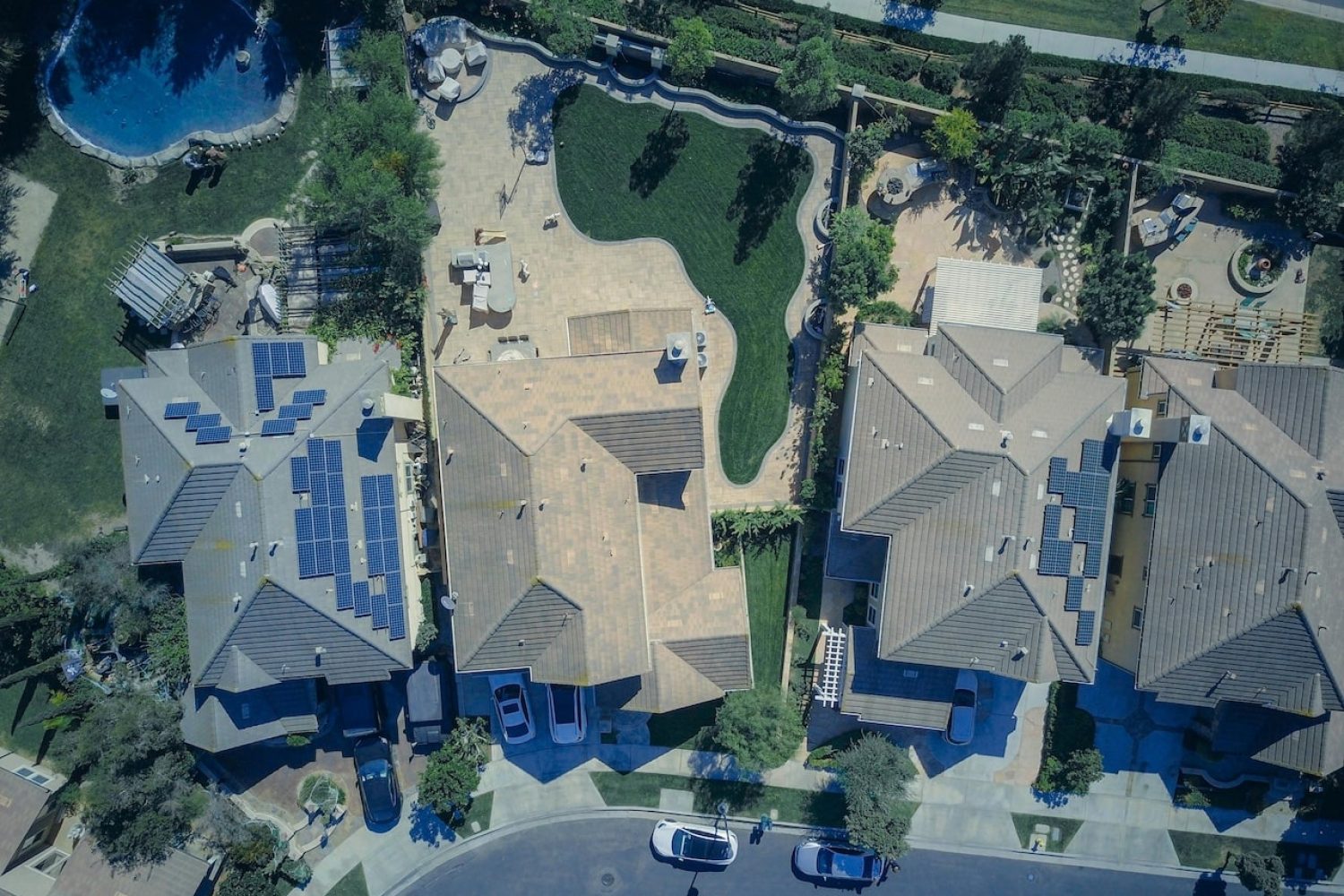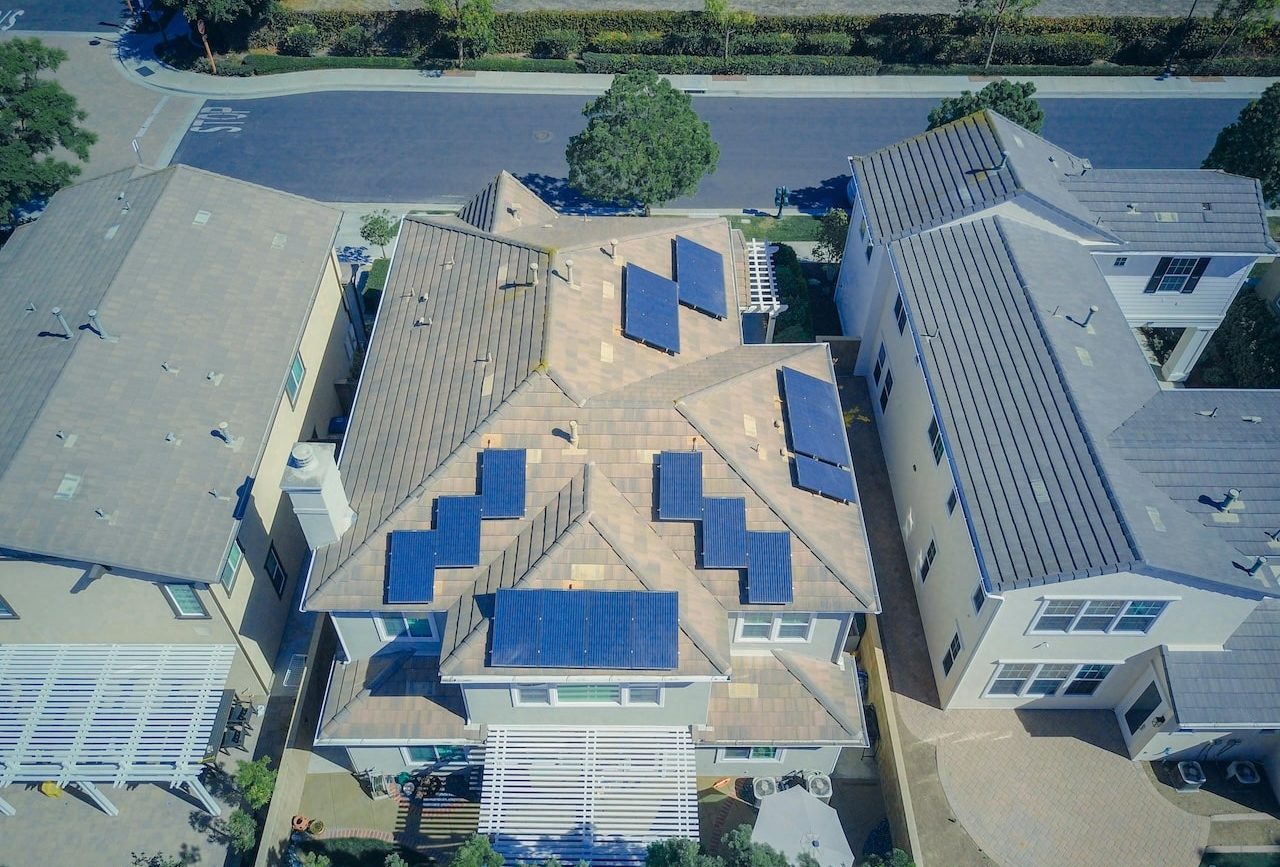Minnesota’s weather is known for extreme freeze/thaw cycles, heavy snow loads, frequent hailstorms, and intense summer heat – all of which take their toll on a roof.
In this article, we’ll explain smart roof technologies available today and those on the horizon. From solar shingles to AI roof inspections, radiant-barrier cooling roofs, and even self-healing asphalt shingles, we’ll outline how Summit Construction Group can help you implement any of these for a longer-lasting, energy-efficient roof.
What makes a roof “smart”?
A smart roof involves connectivity, whether from data monitoring, advanced materials, or energy management components.
IoT roof monitoring lets homeowners view leak, snow load, and drainage data in real time through a connected dashboard. For instance, an attic temperature sensor ties into smart ventilation systems to regulate airflow and reduce ice dam risk. Heated roof cables smart control activate only where and when needed, lowering energy costs compared to constant-on systems.
Examples of today’s smart roofing
Today’s smart roofing systems include:
- Solar integrated shingles or tiles paired with inverters and battery storage. Popular systems include the Tesla Solar Roof or GAF Timberline Solar, which are building integrated photovoltaics (BIPV) roof examples.
- Roof monitoring systems with roof moisture sensors, snow load, and attic temperature sensors that push data to apps for real-time alerts.
- Smart gutter heat trace systems and roof cables that have smart control which activate where and when needed to prevent ice dams.
- Drone roof inspections operated by FAA Part 107 roofing. Certified pilots provide safe, high-quality roof images and even 3D roof mapping.
Smart home energy integration lets solar roofs link directly with thermostats, EV chargers, and battery systems for seamless efficiency. Emerging technologies are also bringing predictive maintenance powered by AI, infrared roof inspections, and whole-home integrations that connect solar generation to the rest of your energy system.
Benefits for Minnesota homes
Installing an ice dam prevention system with smart controls helps reduce the freeze/thaw damage common in Minnesota roofs, and smart targeting de-icing focuses only on high-risk areas instead of heating an entire roof.
A snow load sensor roof sends alerts when the weight reaches critical thresholds. The combination of a temperature-regulating roof with a roof energy monitoring system helps balance attic temperature between summer and winter. Finally, energy efficient roofing technologies can reduce household utility costs while improving year-round comfort.
Solar-integrated smart roofs
Options and what to expect
An integrated solar roof eliminates bulky racks by embedding power generation directly into the roofing system. Low-profile electrical components like wiring and inverters for solar shingles are designed for easy integration to the roof, with minimal maintenance hassles.
Smart shingles combine the look of traditional asphalt with embedded solar and monitoring technology for a seamless roof upgrade. While rack-mounted panels have long been the standard retrofit, today’s available solar shingles, solar roof shingles, and fully integrated roofs are starting to flip the industry.
When it comes to roof-first warranties with solar shingles, look for manufacturer warranties that guarantee both the shingles and solar generation, rather than separate roofing or solar-only coverage.
Minnesota-specific considerations
Snow, wind, and ice present unique challenges, so materials designed for better freeze-thaw roof performance are essential to withstand Minnesota’s temperature swings. Quality solar-integrated roofing systems are now offering:
- Snow-ready roofing with proper load ratings and winter solar performance in Minnesota designs to maximize snow shedding.
- Battery storage with solar roofs to capture power during shorter daylight hours.
- Serviceable inverters that are kept indoors to prevent damage from extreme temperatures
- Hail rated shingles in Minnesota can reduce long-term storm damage and may qualify for insurance discounts.
- Ice dam roof solutions include roof de-icing systems as well as leak alert roofing apps for extra piece of mind.
Budget and incentives
The upfront costs for smart roofs with solar are higher than standard roofs, but it can help with ROI. Homeowners can take advantage of:
- Solar roof incentives in Minnesota exist, including state rebates and utility programs. The federal solar tax credit roof program further lowers the upfront investment for solar shingles.
- Net metering and solar shingles allow homeowners to earn bill credits for excess power sent back to the grid.
Explore solar roofing options from Summit Construction Group.
Temperature-regulating roofs
Cool roofs and radiant-barrier concepts
Applying a reflective roof coating or high emittance roof coating can lower cooling costs by bouncing solar heat away from the building, while a temperature regulating roof reduces attic heat in summer while balancing insulation needs in winter.
Roof ventilation monitoring systems and ridge vent sensors can also help regulate attic airflow to balance temperatures year-round. Roof smart thermostat attic fans automatically adjust ventilation to reduce ice dam risk and summer heat build-up.
Advanced coatings and materials
Next-generation roofing solutions are designed to protect surfaces and regulate temperature more effectively. A nano coating roof repels water and dirt, reducing algae growth and extending shingle life. A phase change materials roof (PCM) moderates indoor temperatures by absorbing and releasing heat as conditions change. A PCM attic insulation uses encapsulated compounds to do the same, evening out temperature swings between day and night.
Drone technology in roofing
How drones are changing roof inspections
Roof drone mapping creates precise measurements that help both insurance documentation and contractor estimates. A roof condition report drone package often includes annotated images, 3D roof modeling, and insurance-ready documentation. A thermal imaging roof inspection can uncover hidden insulation gaps and moisture issues without invasive tear-offs.
Drones have changed the game for roof inspections and documentation:
- Safety: Fewer hours on steep roofs means less risk for contractor crews.
- Data quality: Infrared roof inspections, AI roof inspections, and thermal imaging all open a new window for identifying hidden leaks or failed insulation.
- Insurance-ready reports: Insurance roof claim photos and condition reports from drones make it easier to file claims.
When to request a drone inspection
After major storms, a hail damage roof inspection using drones and AI mapping helps speed insurance claims, especially when combined with Class 4 impact resistant shingles – the best choice for hail-prone areas of Minnesota.
Homeowners should also consider drones for post-storm roof inspections and damage, documenting claims, complex or taller roofs, and even real estate sales where high-quality imagery is an asset.
Roofing materials of the future
Self-repairing roofs and advanced coatings
Self-healing asphalt shingles are an exciting new development. Ongoing research into micro-encapsulated rejuvenators aims to repair the small cracks created by UV exposure and freeze/thaw stresses over time.
Other advanced roofing materials on the horizon include:
- Radiative cooling roof paints and high-emittance coatings: Reflect and release solar heat to increase occupant comfort.
- Hydrophobic and superhydrophobic nano coatings: Repel water and dirt to reduce algae growth and extend roof life.
- Photocatalytic self-cleaning coatings: Break down organic matter on exposure to sunlight.
- Anti-icing roof coatings: Reduce ice adherence to roof surfaces.
Inspections, warranties, and documentation
Inspection and diagnostics
- Visual walk-through: Low – basic condition check.
- Drone photo report (FAA Part 107): Low-Medium – safer access, insurance-ready images.
- Infrared/thermal + AI mapping: Medium – moisture/insulation anomalies located without tear-offs.
- Drone + thermal + 3D roof modeling: Medium–High – best documentation for complex roofs or claims.
Warranty considerations
Homeowners should ask:
- Will advanced coatings or add-on tech void or reduce shingle warranties?
- Can the homeowner monitor and track this via a roofing data dashboard?
Documentation best practices
Keep a dashboard of drone photos, invoices, serials, sensor logs, and maintenance dates for warranty and insurance proof.
Smart upgrade pathways and ROI
Upgrade options:
- Reflective/high-emittance coating (cool roof): Low-Medium – strongest ROI on sun-exposed slopes; verify warranty impact.
- Rack-mounted solar (existing roof): Medium-High – faster to deploy; visible racking; separate roof/solar warranties.
- Solar-integrated shingles (during reroof): High – best curb appeal, consolidated “roof-first” warranty; plan inverter/battery locations for winter.
- Battery storage / inverter upsizing: Medium-High – optional; improves self-consumption and resilience.
Timing & ROI tips:
- Bundle upgrades with a reroof to avoid double labor and maximize ROI.
- Net metering can credit excess generation; winter performance improves with snow-shedding designs and timely clearing.
- Class 4 impact-resistant shingles may offer insurance benefits; drone reports can speed claims.
Targeted Add-ons
- Leak/moisture, attic-temp, snow-load sensors + app: Low – fast retrofit; battery changes as needed.
- Smart de-icing (heated cables/smart gutter heat trace): Low-Medium – ongoing electricity use during freeze events.
How Summit Construction Group helps you choose
Working with an experienced Twin Cities roofer ensures your smart roof is installed for Minnesota’s climate extremes. At Summit Construction Group, we pride ourselves on being Minnesota roofing contractors that are technology forward but still rooted in our customers’ local climate realities. Some of our offerings include:
- Smart and tech-forward inspections: Thermographic, infrared, drone, or other enhanced inspections. Solar-integrated roofing options, specifically designed for Minnesota’s unique mix of snow, wind, and sun.
- Clear breakdowns: Must-do repairs, routine maintenance, and optional smart upgrades for the home such as reflective coatings, roof snow sensor alarms, and home energy integrations.
- Step-by-step guidance: Warranties, local rebates, and performance expectations, both as a stand-alone roof replacement or upgrade, or as part of a smart roof suite of options.
Contact Summit Construction Group directly to request a free, no-pressure smart roof assessment.
FAQs
What exactly counts as a smart roof?
Any roof that incorporates energy generation, monitoring sensors, or specialized coatings for improved energy efficiency and/or reliability.
Are solar shingles a good fit for Minnesota winters?
Yes. Quality solar roof shingles are designed with snow-load ratings in mind and help the snow shed effectively.
Do cool roofs or radiant-barrier roofs only work in the summer, or do they add winter value as well?
They primarily reduce summer cooling loads but won’t make a winter heating system less efficient with a good level of insulation.
Will drones replace walking-on-roofs inspections?
Drones won’t replace inspections entirely, but there are many cases where roof drone inspections will be the preferred route due to safety and higher data quality for clients.
How do leak-detection sensors get applied to existing roofs?
Wireless roof leak detection sensors can usually be retrofitted under shingles or up in the attic.
Do coatings void shingle warranties?
Some roof coatings will void a roof warranty. Check with your contractor before applying reflective or nano coatings.
Can smart roofs and roof sensors reduce ice-dam risk?
Yes, with roof cables, smart gutter systems, and attic ventilation monitoring that can be set to work with sensors.
What kind of inspection data will insurers accept?
Certified roof condition reports from drones are usually acceptable, as long as they have photo documentation.
How do phase change materials work?
Phase change materials work to smooth out temperature swings by absorbing and releasing heat as they move through different states of matter. These materials are just starting to come to market for residential use but have a lot of potential in Minnesota.
What kind of maintenance will smart components need?
Battery replacements for certain sensors, app updates for smart features, and occasional cleaning of solar generation components.
How long do solar roof warranties last, and what do they cover?
The typical range is 20–25 years and covers roofing materials along with energy output guarantees.
Smart roofs in Minnesota
A smart roof is the best way to prepare Minnesota homes for decades of storms, snow, and sun. By bringing together solar-integrated shingles, drone roof inspections, and next-generation materials like ice-dam resistant coatings and phase change attic insulation, it’s possible for homeowners to future-proof their roofs against surprise failures and costly repairs.
Summit Construction Group is here to help with both the guidance and technology, as well as the hands-on experience necessary to make these systems perform for. If you have questions about solar rebates or incentives or simply want to learn more about your options, it’s the right time to get started. Check out our roofing FAQs or contact Summit Construction Group to request a free no-pressure smart roof assessment.




